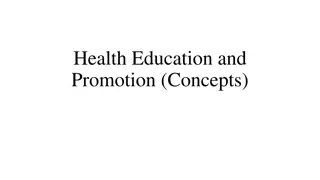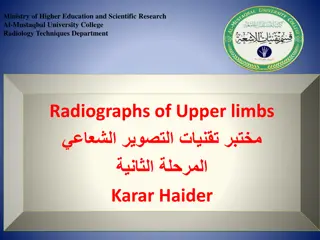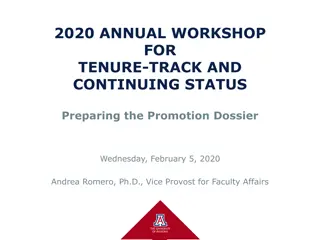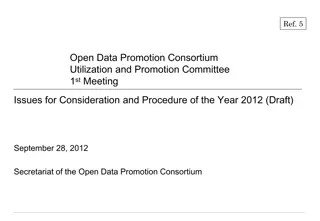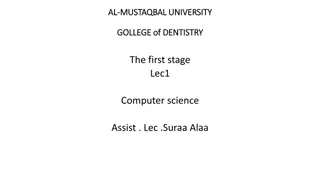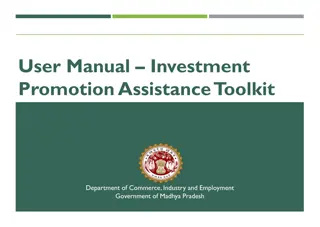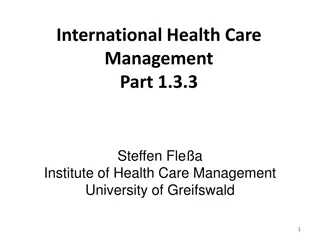Health Education and Promotion at Al-Mustaqbal University
Health education plays a crucial role in promoting well-being and preventing diseases. This content explores the significance of health education, focusing on communication, teaching methods, and the benefits it brings. It emphasizes the importance of educating individuals and communities to empower them to make informed decisions about their health.
Download Presentation

Please find below an Image/Link to download the presentation.
The content on the website is provided AS IS for your information and personal use only. It may not be sold, licensed, or shared on other websites without obtaining consent from the author.If you encounter any issues during the download, it is possible that the publisher has removed the file from their server.
You are allowed to download the files provided on this website for personal or commercial use, subject to the condition that they are used lawfully. All files are the property of their respective owners.
The content on the website is provided AS IS for your information and personal use only. It may not be sold, licensed, or shared on other websites without obtaining consent from the author.
E N D
Presentation Transcript
Psychosocial theory Prepared by Dr. Kareem G. Dhaidan Kareem AL-Khafajy
Erikson's Concept of Development Erik Erikson's stages theory of psychosocial development contributed to our understanding of personality development throughout the lifespan.
Erik Erikson was born June 15, 1902. Died May 12, 1994. 3
Erickson describes eight developmental phases. Five of these phases attribute to childhood and three attribute to adulthood. Erickson uses the word sense to describe the affective states being dealt with in the progression (sequences) of development in each phase.
Development for Erickson is Tridimensional: 1. There is the progression from one phase to another. 2. Development involves a set of mutual shared) (feelings: A. Between infant and one-child-caring person (mother). B. Between child and child caring persons later. C. Between child and peers. D. Then between adolescent and his peers. E. In early adulthood, mutuality is between intimate friends and parents. F. Later between generations. 2. Development is relative.
Developmental phases of Erickson: Age Characteristic of Dellema Trust versus mis trust Autunomy versur shame and doubt Initiative versus guilt Industry versus inferiority Identity versus role confusion Intimacy versus isolation Generativity versus stagnation Integrity versus despair - birt to one year - 1 to 3 years - 3 to 5 years - 6 to 12 years - Adolescent - Young adulthood - Middle adulthood - Late adulthood Kareem AL-Khafajy
Phase I: (birth 1 year), a sense of basic trust V/S basic mistrust. *Phase I, starts from birth till the end of the first year of life. *The infant acquires a sense of basic trust while overcoming a sense of basic mistrust. 7
Affective development, that is, emotional development, is started in the very early experience of this phase. Infants are born with their basic abilities needed for extra-uterine survival, such as respiration, thermoregulation and digestion. They cannot survive without the care given to provide for those essential needs such as food, warmth and, security.
For the newborn, a sense of trust requires a feeling of physical comfort and a minimum amount of uncertainty (insecurity) and discomfort. In contrast, a sense of mistrust arises with unsatisfactory physical experiences and the association of frustration with them. Frustration. leads to feeling of fear and lack of hope for finding the desired change. Trust helps the infant to feel confident in himself as well as in others. 9
*During the first 3 to 4 months, much of the infant's routine centers around the intake of food, light, sound and around general bodily tactile stimulations. Oral contact and sucking alleviate (relieve) discomfort while providing them with a source of satisfaction. 10
*Love and pleasure of dependency, which is important in this phase, are given or provided to the child through his mother or the care giver by her comforting warmth, smile, and way of talking, as well as through the quality of care. The infant develops a sense of trust when he learns that his outside world is a giving one and when his needs are satisfied properly. *A sense of mistrust develops when there is too much or too little frustration resulting from too late gratification (satisfaction)of needs. Kareem AL-Khafajy
Phase II: (1- 3 yrs.), a sense of autonomy V/S a sense of doubt and shame. *Whenthe infant gains trust in his outside world and way of life, he is ready to acquire a sense of autonomy and he realizes his will. *He starts to practice being independent; however, his continued dependencies create a sense of doubt in his abilities and capacities, and also createa senseof shame for continuing to be dependent on his mother. 12
Specific developmental tasks a toddler will deal with: 1. Differentiation of himself from others, particularly his mother. 2. Toleration of separation from mother, parents, and family. 3. Ability to interact with others in less egocentric (selfish), autistic manner. 13
Characteristics of typical autonomy: 1. Negativism: the toddler starts to use the word "No" 2. Ritualism: doing certain actions or behaving in a ritual manner i.e. repeat certain behavior several times. 3. Emotions becomes very strongly expressed, e.g. one minute the child can be involved in an activity and the next minute he might be violently angry because he was unable to manipulate a toy or to open a box or a door.
Temperament (is the manner of thinking, behaving or reacting characteristic of an individual and refers to the way in which a person deals with life) may appear if he is scolded for doing something wrong. Kareem AL-Khafajy
Phase III: (3/4 5 yrs), a sense of initiative and V/S a sense of guilt. *The child in this phase starts to be more active and positive in performing certain tasks. *Erickson refers to these developmental years as the "Play age". *The use of the language in this phase is improved. 16
*Psychological development in this phase centers in to major tasks: 1. The child begins his relationship with others such as parents, peers, and other adult in the life. 2. The child begins to notice sex differences the children are now experiencing being a boy or girl.
Phase IV: (6 11 years), A sense of industry V/S inferiority *The divergence of this phase is a sense of industry versus a sense of inferiority. *The child's energy is directed toward inventions and production. *Beginning to create, develop, and manipulate. *Developing sense of competence and perseverance. 18
Phase V: (12-20 years), Identity V/S Identity diffusion *Asense of identity means a sense of being at one with oneself as one grows and develops. *Identity development is closely linked with the mastery of skills. *Achieving a sense of identity as well as overcoming a sense of identity diffusion *Children physically mature into adulthood; they experience rapid body growth, important physiological and anatomical changes. Previous trust in their body and their mastery of its functions is suddenly shaken.
Young adolescents experience a close attachment to their parents while they reach for new and more satisfactory contacts in association outside the family. They learn to interact with more and more people at a given times and they learn in which way they should relate to them. In this process they become individuals in and members of their community. Adolescents develop their relationship with significant adult in his/her life. Identity development moves from the reality of being to the reality of becoming 20
Phase VI: (20-40 years), a sense of intimacy and solidarity V/S Isolation. *This period is a time to enjoy life with adult liberty and responsibility. *The major developmental theme now involves psychological readiness and a commitment to mutual intimacy in the partnership of marriage. *In this phase a foundation is prepared for the couple's own life and the lives of others. Graduation from adolescence requires a sense of shared identity. *Intimacy involves a balance between giving to other and maintaining oneself.
Phase VII: (40 - 60 years): a sense of Generativity V/S self absorption. *The second of developmental phase of adulthood deals with assuring care for the new generation. *Generativity refers to the care they provide as a unit in society at large to the next generation. *It is the period in life when individuals are productive in work to satisfy themselves and people beyond their own family borders. 22
Phase VIII: (60 years & above): a sense of Integrity V/S Despair. *Integrity refers to the acceptance of the individual life cycles of human beings as something that has to be. If in old age one prefers not to be what one was not meant to be, one has found a sense of integrity. *It includes overcoming a sense of despair, a sense of disgust at certain life styles, and a fear of death at the end. *In this phase, one often finds wisdom and a philosophy of life which extends beyond one's own life cycle to future developmental cycle. *With a faith and trust in generations, Erickson says" healthy children will not fear life, if their parents have integrity enough not to fear death". 23




